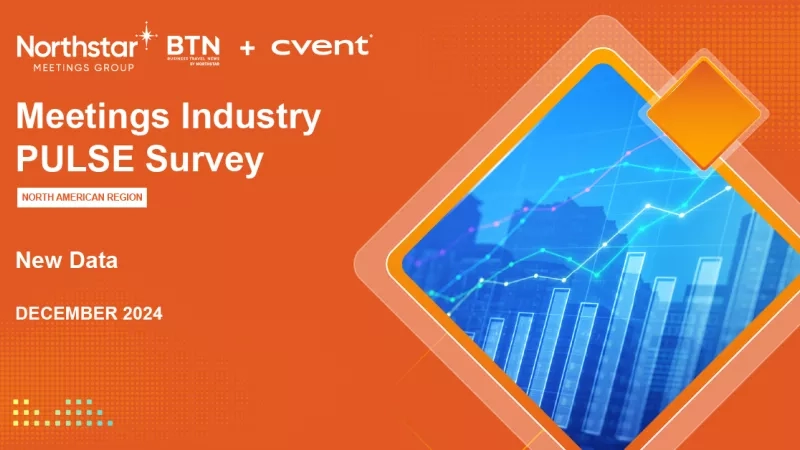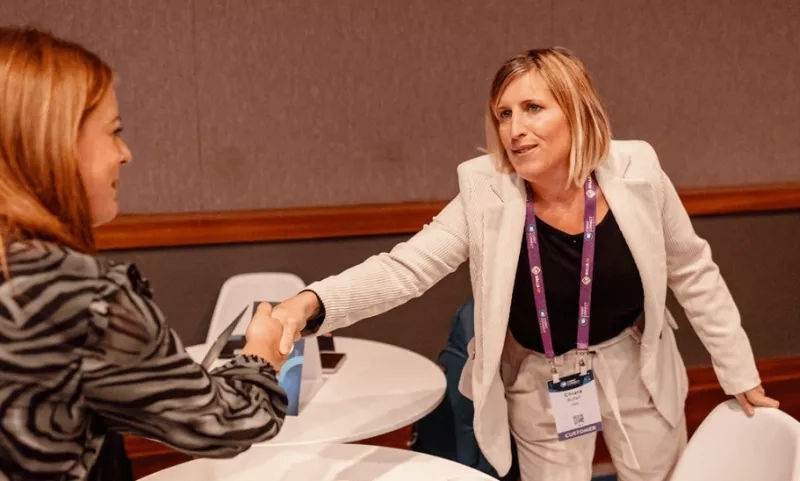Speed networking describes a business tactic where event attendees can meet and network with multiple other attendees in a short period of time. Through speed networking, participants are given a structured way to meet more people at events.
We're all different—big surprise! This has never been more evident when it comes to traditional networking events. One size does not fit all, so it's important to create unique and different ways for people to connect. Speed networking offers a fast-paced alternative to meeting many professionals in a short amount of time. And it's gaining momentum.
This post is your guide to speed networking—we'll break down what it is, how to organize your event, and what questions to ask at a networking event, and we will equip you with tips and tricks to make the most of them.
What is Speed Networking?
Speed networking, also known as Business Speed Dating, is a highly efficient and time-saving approach to making professional connections. It can take several forms, but the aim is to meet as many people as possible as quickly as possible.
The concept of speed networking was first introduced in the early 2000s by Tom Jaffee, who adapted the idea of speed dating for the corporate world. However, unlike speed dating, the goal of speed networking is not to find a single, compatible match but rather to make multiple relevant connections that can benefit one's career or business.
Did you know that 85% of jobs are filled through networking?
How Does Speed Networking Work?
Speed networking is a structured event that allows participants to have brief, one-on-one conversations with multiple people quickly. As mentioned before, the goal is to make as many connections as possible and exchange information quickly.
Participants are seated at tables or in a circle during a speed networking event. They have a set amount of time (usually a few minutes) to introduce themselves and converse with someone across from them. When the time is up, a bell or buzzer sounds, and one group of participants moves to the next table or person.
The process continues until everyone has had a chance to meet and speak with each other. Participants are encouraged to take notes and exchange business cards or contact information with those they are interested in connecting with further.
Speed networking can be conducted in person or virtually, and the format can vary depending on the event's goals and the organizer’s preferences. Some events may have a specific theme or focus, while others may be more general.
What is the Purpose of Speed Networking Events
Speed networking events allow participants to make multiple professional connections quickly. Participants can expand their network, learn about new industries, find jobs or business opportunities, and gain insights from other professionals by engaging in a series of brief, focused conversations with various individuals.
What are the Benefits of Speed Networking?
While speed networking can be an effective way to meet many people quickly, it's important to consider its advantages and disadvantages. Here are some key points to keep in mind:
Advantages of Speed Networking:
- It encourages you to talk to someone new and get straight to the point without any uncomfortable small talk.
- It simplifies the stressful process of finding time and a location to chat, lowers the pressure, and encourages people to open up.
- It brings new groups together in large organizations and encourages individuals to form meaningful, valuable connections.
- It can be used to connect like-minded people from different organizations.
Disadvantages of Speed Networking:
- Some people may only participate to promote their products or services, rather than to form meaningful relationships, join in discussions, or share ideas.
- Attending a speed-networking event does not automatically increase the size of your network. You need to cultivate the seeds of new relationships afterward for them to grow.
- The short time frame for each interaction may not allow for in-depth conversations or meaningful connections.
- It can be overwhelming to meet and try to remember a large number of people in a short amount of time.
- Some people may feel pressured to make a good impression in a limited amount of time, leading to anxiety or stress.
What is the Format for Speed Networking Events?
There are three primary formats for organizing speed networking events, each with its own unique approach to facilitating connections between participants.
Round Robin Model
In this model, interactions happen in a predefined sequence, allowing participants to meet different people. The meetings start with a buzzer, and during the first round, participants exchange essential information.
Once the first round is complete, the host begins the second round. The average maximum number of contacts a participant makes during an hour-long round-robin session is 10. However, it's important to note that not all participants may be relevant to your background or interests.
How to run a Round Robin Event:
- Create a list of participants and assign each one a number.
- Determine the length of each round and how many rounds you want to have.
- Use a speed networking tool to generate a seating plan that pairs participants for each round.
- At the end of each round, have participants rotate to their next assigned seat.
Station-Based Model
In this model, meetings between participants are pre-set before the event based on information shared in a questionnaire filled out by participants. Participants also identify which professionals they want to meet during the speed networking event. The average maximum number of contacts a participant makes during an hour-long station-based session is 10.
Group-Based Model
The group-based model is often considered the most effective of all three models.
Use networking event platform to generate an optimal seating system. Each table may consist of 4-10 chairs, and the participants at every table have a set amount of time to introduce themselves. Since the tool generates a seating plan that encourages the creation of valuable connections, the probability of achieving success during such events is very high.
To run a group-based speed networking event:
- Determine the number of tables and chairs needed based on the number of participants.
- Use software to generate an optimal seating plan that encourages valuable connections.
- Set a time limit for each round of introductions.
- After each round, have participants rotate to a new table.
5 Key Steps to Organize a Successful Speed Networking Event
Organizing a successful speed networking event, in-person or virtual, requires careful event planning skills and attention to detail. Here are five event planning steps to create an effective speed networking session:
- Define the event's purpose: Identify your goals and desired outcomes. Why do you want people to attend? What do you want them to achieve? How will this affect how you run your event? For example, you could focus on helping everyone meet as many people as possible or maximize learning with longer rotations and more time to connect.
- Choose the format: The event's format and the room setup will depend on how you intend people to meet. For in-person events, you could use long tables with chairs on both sides or set up small round tables for small-group speed networking. For virtual networking events, you could use a video conferencing platform for breakout rooms or one-on-one chats.
- Select your invitees: Determine how many people you will invite. This number depends on your purpose and the time you have available. For example, you'll need more than three hours for 50 people if you want everyone to meet for at least four minutes. In general, groups of 16 to 30 people work best. Remember to have an even number of attendees to avoid leaving anyone out.
- Inform your guests: Prepare your guests ahead of time by setting an agenda and sharing a list of attendees. This will help them understand the event's purpose and the length of the rotations and allow them to prepare meaningfully for the event. Send out any necessary login information and instructions for using the video conferencing platform for virtual events.
- Consider other logistics: Consider the venue, food service, and event timing. Ensure your organization can accommodate the group or rent a private space for in-person events. Consider reserving food service for the beginning or end of the event. Give a brief introduction at the start of the session to explain the ground rules and discuss the agenda.
You could also leave time at the end for open networking so people can have follow-up discussions. For virtual events, choose a platform that can accommodate the number of attendees and has the necessary features for your event. Consider using breakout rooms or one-on-one chats for follow-up discussions.
5 Speed Networking Tips
Here are some tips to help you organize an effective and engaging speed networking event:
- Simplify the Registration Process
Utilize available tools to streamline the registration process. As an organizer, you must be prepared for the number of participants you expect. Make the sign-up process easy and require attendees to fill out forms that ask for professional background information. This will give you a clear idea of who will attend and help you organize the session accordingly. - Choose a Group-Based Speed Networking Model
A group-based speed networking model is often the most effective. Use the information gathered during the registration process to create an optimal seating plan that encourages the formation of valuable connections. This will increase the likelihood of your event's success. - Learn from Others
If this is your first time organizing a speed networking event, seek out ideas and advice from professional groups, such as the Networking Events Organizers Group on LinkedIn. Don't be afraid to ask questions and learn from others who have experience organizing successful speed networking events. - Utilize Technology
Incorporate technological tools into your planning process to maximize engagement at your speed networking event. For example, registration tools can be used to simplify the process, or speed networking seating chart apps can be used to create an optimal seating plan. Don't rely solely on your skills – let technology assist you in making informed decisions. - Follow up after the Event
Send attendees a feedback survey and ask what they liked or disliked. Collect suggestions for future events and encourage attendees to connect on LinkedIn or other professional networking platforms.
Speed Networking: Example Questions for Different Scenarios
Asking icebreaker questions is one of the many ways to facilitate networking at events. Here are some examples of good networking questions that can be used during in-person and virtual sessions:
Speed Networking Questions for Any Event Type
- Where would you go if you could take a spontaneous trip this weekend?
- Can you share a difficult lesson you've learned in your career and how it has helped you grow?
- Is there a podcast or YouTube channel that you're currently hooked on?
- What do you like to do to relax and unwind after a long day?
- Are there any causes or charities that you feel particularly passionate about?
- What is a skill that you're currently working on improving?
Networking Questions to Ask Mentors
- What key decisions or turning points in your career have brought you to your current position?
- Can you share a significant challenge you faced in your career and how you overcame it?
- How do you envision our industry evolving in the next 5 to 10 years, and what steps can I take to stay ahead of the curve?
- Are there any daily or weekly habits or routines that you believe have contributed significantly to your success?
- Can you recommend any books, podcasts, or courses that would benefit someone looking to excel in our industry?
- What skills do you think are essential for success in our field but often overlooked?
Other Networking Icebreaker Questions
- What motivated you to pursue a career in this industry?
- What do you enjoy most about your job or industry?
- What's the best piece of advice you've received in your career, and how have you applied it?
- If you could switch careers tomorrow, what would you do and why?
- What's one skill you'd like to develop or improve upon in the next year?
- What's one thing you wish you could tell your younger self about your career journey?
FAQs
How long is a speed networking session?
The length of a speed networking session can vary depending on the event and the organizer's preferences. Typically, each individual networking interaction lasts between 3 to 10 minutes. The total duration of the event can range from 30 minutes to 2 hours or more, depending on the number of participants and the event's format. Some events may have multiple rounds of speed networking, while others may have a single session.
How do I prepare for a speed networking event?
Preparing for a speed networking event can help you make the most of the experience and increase your chances of making valuable connections. Here are some tips to help you prepare:
- Research the event and attendees
- Set clear goals
- Prepare your elevator pitch
- Bring business cards
- Dress appropriately
- Prepare questions
- Follow up
The Future of Networking: Speeding into Success
Traditional networking events can feel like wading through a crowded room, hoping to snag a meaningful conversation. Speed networking offers a refreshing alternative – a fast-paced, efficient way to forge valuable connections in a short amount of time.
This comprehensive guide has equipped you with everything you need to host speed networking. From understanding its purpose and mastering the art of crafting conversation starters to organizing your event, you're now armed with the knowledge to make the most of these power-packed encounters.
The future of networking is all about intentionality and efficiency. Speed networking allows your attendees to connect with a diverse range of professionals in a targeted way, maximizing their time and effort. Here’s to creating a speed networking event that sparks meaningful connections and ignites business opportunities!
Up next, read 14 innovative networking event ideas that engage, surprise, and inspire deeper business connections.









